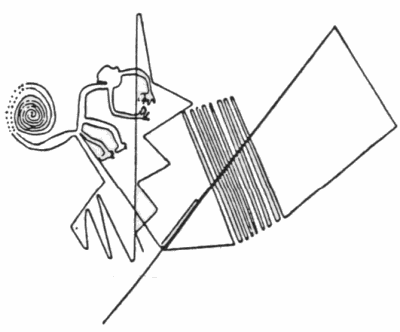 |
Science Frontiers ONLINE No. 134: MAR-APR 2001 |
|
|
Water Signposts, Ritual Paths
Actually, no words as such are inscribed, rather there are huge biomorphs (for example, a pelican 1,000 feet long) and geoglyphs (a trapezoid enclosing 160,000 square yards). Overlaying and mingling with these pictographs is an apparent hodgepodge of hundreds of straight lines, one of which is 9 miles long. It is a confusing canvas to say the least.
This gigantic terrestrial easel covers 400 square miles. Upon it are drawn more than 1,000 biomorphs and geoglyphs, plus some 800 straight lines. It is one of the world's great archeological legacies from the deep past.
Actually, at least two canvasses seem to be superimposed. The earliest canvas consists of the geoglyphs, which were incised beginning about 200 B.C. Peel away these, and we are left with the geometrical figures and straight lines. These seem to have been inscribed starting about 600 A.D. -- a time of severe drought, which may be a clue to their purpose.
Next, strip off the geoglyphs (trapezoids and such), and a seeming mishmash of straight lines survives. But most are not random when analyzed. Most converge spoke-like upon 62 or more "ray centers."
Thus, the Nazca Plain seems to be a 3-page book: biomorphs, geoglyphs, and spoked ray-centers. They all overlap. It's all a gigantic Rorschach test; and different observers see different things!
 A Nazca biomorph (monkey with spiral tail) overlain by an abstract, unexplained geoglyph. See Book Supplement for still another Nazca figure.
A Nazca biomorph (monkey with spiral tail) overlain by an abstract, unexplained geoglyph. See Book Supplement for still another Nazca figure.
|
Of course, there are doodles on this 400-square-mile canvas that don't fit on any of the three pages. We'll have to ignore them for now. The archeoastronomers first tried to read something meaningful into the Nazca lines, but they were disappointed. Computer analyses revealed no significant connections with the rising and settings of heavenly bodies. Next, some tried to relate the biomorphs to the celestial sphere. Did a terrestrial bird figure point toward a bird-like grouping of stars? A few earth-sky bird connections are interesting in this regard, but generally the idea that the Nazca lines are a terrestrial zodiac has not panned out well.
The geo-speculators have had more success. There are many "water" connections.
- The geoglyphs were drawn at the time of a great drought.
- The geoglyphs are often colocated with groups of subterranean aqueducts called "puquios," which were constructed during the drought.
- The "ray centers" are usually located near water sources.
- The trapezoids are generally oriented parallel to the flow of surface water. �Seashells and ceremonial drinking vessels have been excavated near the trapezoids, suggesting water-connected rituals.
- Fossil footpaths follow many of the Nazca lines.
Accumulating evidence has led many archeologists and anthropologists to conclude that some of the Nazca lines are ritual pathways, meant to be walked upon and to lead processions to spots where prayers for more water would be most effective. The geoglyphs, however, remain mysterious.
(McClintock, Jack; "The Nasca Lines Solution," Discover, 21:74, December 2000.)
Comments. The Nazca lines have not been neglected in past newsletters. See SF#47 and SF#63.
Ritual processions like those hypothesized for the Nazca Plain resemble thosethought to have taken place along Avebury's avenue, Carnac's stone rows, and Chaco Canyon's mysterious converging system of "roads." Ritual processions seem to be built into the human genome.
Other Sites of Interest
|